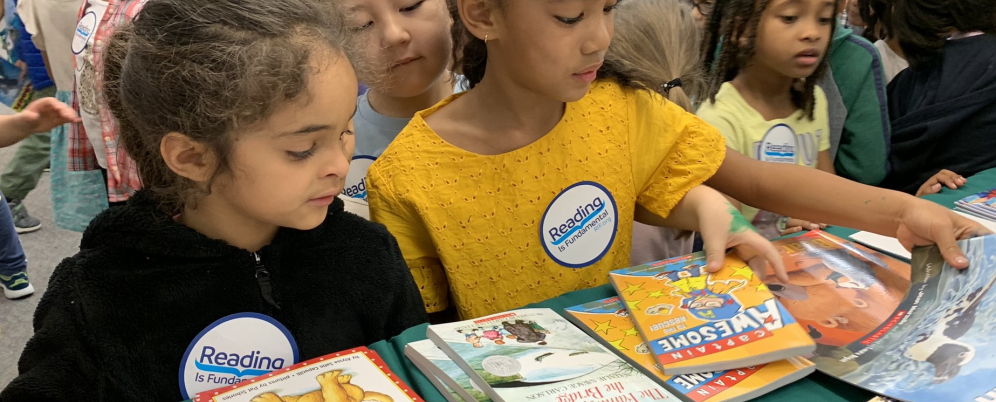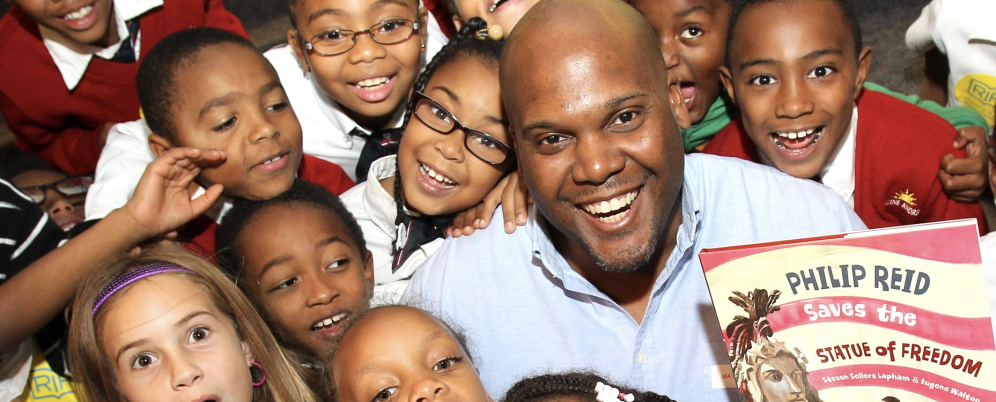If You Can’t Beat the Scroll, Spark Curiosity Instead
Through the power of storytelling, children discover and develop their passions, sense of wonder, and unbridled imagination. At Reading Is Fundamental (RIF), we strive to provide students with books and reading resources that they can own and enjoy, leading to lessons and memories that stretch from their homes to their classrooms. Utilizing RIF’s digital platforms, research-backed programming, and joy of reading framework, we encourage the pursuit of knowledge and adventure that is immersed in a culture of reading. Enlightened Generation, an interactive brand that connects kids, fashion, and education, further encourages curiosity as a doorway to learning, empathy, and growth. Every purchase of their Language & Communications collection support RIF’s mission! Read on to hear from Susan Verde, co-founder of Enlightened Generation, former educator, and New York Times best-selling children’s author, on how to engage children with the mysteries and wonders of the world using stories.
It all begins with a question.
“Why is the moon always following me?”
“What language do people speak on Easter Island?”
“Can animals glow in the dark without batteries?”
I’ve written dozens of children’s books, and I’m a mom of three, but the truth is, those questions still stop me in my tracks. They remind me that curiosity is the heartbeat of learning. It’s also the thing that keeps kids coming back to books.
And yet, I see what we’re all up against. Screens pull attention in a dozen directions. School can turn reading into a chore. Even the best intentions from parents, teachers, and caregivers — myself included — get buried under to-do lists, and the distractions of daily life.
But if we lead with curiosity, if we stay in the question with our kids just a little longer, they’ll discover something more powerful than a reading level. They’ll remember that books are invitations. And that’s where the love of reading begins.
Let the Wiggles Happen
I’ve never met a still child.
They pace. They wiggle. They interrupt with questions halfway through a sentence. And if you’re the one reading to them, you might think: This isn’t working. They’re not paying attention.
But they are.
They’re hearing your voice. They’re feeling your presence. They’re connecting, even if their bodies are in motion. We forget that sometimes — especially when we’re tired, stressed, or worse, worried we’re doing it wrong.
I’ve had moments where I thought, “Why bother if they won’t sit still?” But over and over again, I’m reminded: There’s no one right way to read with a child.
Some kids want a full performance. Some want to flip ahead. Some want to hear the same book twelve times in a row, and some don’t want to hear it at all until you ask a question that lights them up.
We lose them when we start to measure everything. When reading becomes another task to complete. Another box to check.
My youngest has dyslexia and ADHD. For him, reading was hard. It became unbearable when it was mandatory. Yet, when he had a choice — when the book was his — he fought through every page.
That’s the moment we’re looking for. Because when a child wants to know more, they keep reading.
When a Moment is All You Have
Sometimes that moment comes in the car, or while tying a shoe, or halfway through a story they won’t sit still for. And if we’re waiting for the perfect quiet window, we’ll miss it.
So, I don’t think in terms of “reading time” anymore. I think in sparks.
A spark could be one page that makes them laugh. One fact they repeat to a sibling. One pause long enough for a question to land.
When I write, I leave space for those sparks. My goal is to crack something open. To interrupt the scroll, the routine, the expectation of what reading is supposed to be.
Kids don’t need more minutes. They need more reasons to care about the wide world around them.
Turning Wonder into Something You Can Wear
I’ve never seen a child fall in love with reading because they were told to. But I’ve seen it happen when something strange made them wonder. When they had space to ask. When the adult beside them didn’t have the answer but stayed anyway.
That’s the idea behind Enlightened Generation.
We wanted to create something children could interact with long after a book was closed. Each collection starts with a story — something curious, real, and just a little wild. Like the leaf sheep of the sea. Or the Nasca Lines, etched into desert ground.
But it doesn’t stop there. Every box comes with an activity and something tactile, like a T-shirt or leggings, a keepsake that helps the story move into daily life. A child wears their leaf sheep shirt to school, and someone asks, “What is that?” Suddenly, they’re retelling the story. They’re teaching someone else. They’re spreading wonder — and that’s contagious.
Competing with screens is hard enough as it is. Which is why we have to offer kids a different kind of attention. One that lingers. One that lives in the body, not just the brain. One that’s built for the pace of real life, while making a lasting impact. Messy, nonlinear. Just like curiosity itself.
Keep the Curiosity Coming
That’s what we get to offer. Not pressure. Not perfection. Just presence, and ongoing curiosity.
So, if your child asks a question in the middle of a sentence, follow it. If they want to read out of order, let them. If they walk away and come back, pick up where you left off.
That’s still reading. And those are the moments, the sparks, that matter, and will keep them wanting more.
Get Inspired—Read RIF's Blog
Stay connected with the heart of our mission by exploring our blog. We feature stories from communities we serve, literacy tips for educators and families, and updates on how Reading Is Fundamental is helping children across the nation discover the joy of reading.

